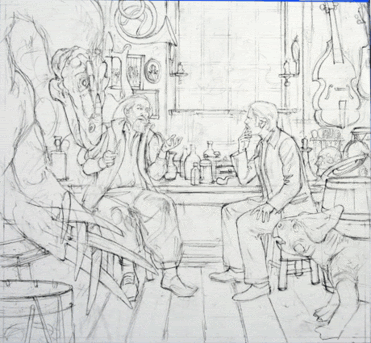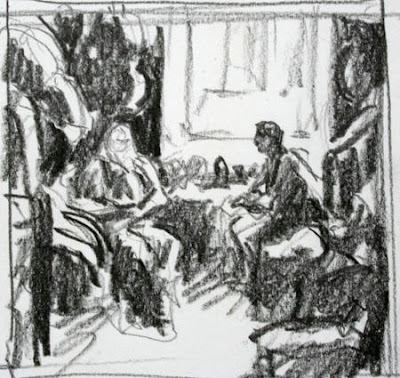
(Direct link to animated gif) This way of painting involves doing a careful pencil drawing on illustration board, sealing it with acrylic matte medium, laying in transparent color, and then proceeding to the finished rendering, area by area, beginning with the center of interest.

EDIT: to answer Tom's suggestion, I've made the animation a lot slower. And Ben, I have added above the preliminary pencil thumbnail showing how I worked out the basic tonal design before getting models and shooting reference. In this case I didn't do a full charcoal preliminary, just this quick (but very helpful) tonal study.
-------
The original painting "Old Conductor" is currently on exhibit at NHIA in Manchester, New Hampshire through March 13.
Thanks to Stapleton Kearns and Lines and Colors for reviewing that exhibit.
Journey to Chandara signed from my web store and from Amazon
More about technique in my book Imaginative Realism .







26 comments:
What a great way to study the progress of a painting!
Is there any way that the viewer can slow down the sequence, or is it pre-determined by the softwared?
I'd love to see more posts like this, if possible.
Thanks!!
It's predetermined, but I could control it and create another. Would people like to see it slower?
Yes please! I'd like to see it slower, or as separate frames.
Don't bother on my behalf alone, James. Just wondering. But my pie-in-the-sky wish list (for what it's worth) would include someday for the viewer to be able to control the speed and to also see it in a larger and high-res version. What a great teaching that would be - not that it isn't great for what it is now.
This is amazing! I would love to see you break down more of your paintings like this, it's always cool to see how an artist approaches their work.
@Tom - If you have Photoshop (Gimp or another software might work in the same way), save the picture as a .gif file and open it in that software. The separate frames should then load on individual layers, and you should be able to view it that way (:
James-
Thanks for sharing this. I love to see the different processes that artists use.
I'm wondering a couple of things:
1. I'm guessing you created tonal and color studies prior to the final painting. Did you create a fully rendered tonal drawing (a la Norman Rockwell) before moving on to the final piece?
2. Would you mind sharing approximately how long you spent creating the painting?
Thanks as always for all that you share with the art community!
I love it, and would also like to see another. Slower would be helpful, I think, to really get a good look at each stage. But what a great idea!
Tom and Catherine, I have reprogrammed and re-uploaded the animation to make it a lot slower. And
Ben, I have added above the preliminary pencil thumbnail where I worked out the basic tonal design. In this case I didn't do a full charcoal preliminary, just this quick (but very helpful) study. The painting took about a week, start to finish.
Thanks, Stuart for explaining. And Natascha, I'll try to do more of these in the future.
Hi James,
I have a technical question I hope you could help me with. Im about to start on a canvas. I've penciled in the line drawing, sprayed with final fixative, sealed with matte medium, and put an ultramarine imprimatura (oil). Its been 3days and I can still wipe some ultramarine off. It seems dry but not adhering? Never had this happen. Any idea whats going on?
If the action return (after), I think it will be much wave.
Ex. imagine 1, imagine 2, imagine 3, imagine 4, imagine 3, imagine 2 and reload algoritm. Like a wave; turn-return!
Sorry, just a suggestion.
Cale, I'm not sure what's going wrong there. What medium are you using? For the washin or imprimatura, you can just use Gamsol to thin the paint to a light wash and then build up the thicker and slower drying paint with the later applications. There shouldn't be any adhesion problems in any case.
Scorchfield, can you please explain what you're talking about?
In GIF the imagines are going one after other, but to the end the refreshing is too hard, because the dinamic is broke.
Why we not understand the moving of the wave with front and back of action?
After last imagine when all is full of colour, we put the imagine when all is empty (wrong, in my opinion).
I think, much better is put penultimate imagine, and so all. (Go and come :) )
example
http://scorchfield.blogspot.ro/2013/02/insula-carnivora.html
Just love the composition of this painting! Great to see the process gif
It's interesting to note some of the detail changes. I see that what appear to have originally been spoon shaped objects below the cello-like instrument on the far wall were replaced by a rack of recorders (?). Also, the pipe next to Dennison's elbow was replaced by a glass beaker.
Do you recall the reason for these changes? Art direction or your own decisions. Just curious...
I agree that slower would be helpful. It would be nice to be able to study each stage a little better rather than simply have a quick glance. Also, the slightly off position for registration might not be as noticeable.
Thank you for posting this! It is always a treat to see how master artists go about creating their work.
It gives a peek over your shoulder without distracting you from your beautiful work.
Tom, I'm glad you noticed the spoons changing into recorders. The nice thing about oil (or any opaque medium) is that such changes are possible. I did that because I wanted more musical instruments. I added the kerosene lamp instead of the clay pipe because I set up a still life and painted it from observation.
Diana, next time I do one of these, I'll make it just a bit slower.
Scorchfield, All the images are in order, and it starts over from the first step after the finish. I don't know how else to do it.
James,
oh yeah, just some OMS for medium and not much of it. Hmm I guess I will wait a while longer. If it continues any harm in trying to wipe it off with oms?
I remembered after I had put down the oil imprimatura that I could have just added a little ultramarine to the matte medium, doh!
Cale, you can do an imprimatura and color block-in with acrylic for a faster dry time. Oil over acrylic is always OK, but not vice-versa.
Thanks for sharing James, this is a real delight! Where did your color choices come into this process? Did you do any smaller color studies, or just attack it during the final painting? Thanks again, this blog is a tremendous resource for the art community.
Wow. This is a really neat way to view your process. Always intriguing! I find this particular approach very interesting. I do detailed pencils like that for my watercolors but rarely oils. Very cool. Thanks for sharing! P.S. Another way to make these GIFs is using Photoshop's "Animation window." (At the top, you can select "Windows" then "Animation" and manage the layers as frames.)
How did you keep the illustration board from warping?
John, it's heavyweight board, so it doesn't warp. But usually if you have a board that warps from a water medium on one side, just paint the back with water and it usually counteracts the effect.
Amazing! But I have to ask why and how did the floor go from darker to lighter ? Is it through layering of colors like oils and acrylics or did you start with a more manipulatable medium, like watercolors?
Krystal--good eye! I lightened to the floor with opaque oils to suggest the specular sheen of reflected light from the window.
Post a Comment